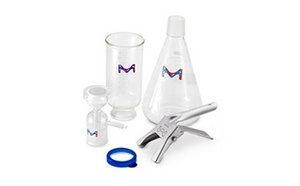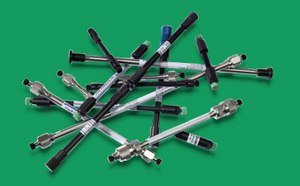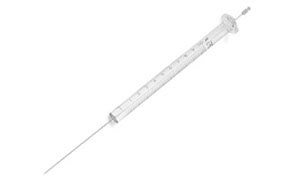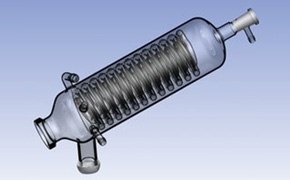小分子HPLC

小分子分析
小分子指低分子量化合物(通常小于900道尔顿)。常见小分子包括氨基酸、脂质、糖类、脂肪酸、生物碱等。
现有多种分离小分子的方法,包括高效液相色谱(HPLC)、液相色谱(LC)、气相色谱(GC)、薄层色谱(TLC)和毛细管电泳(CE)。此外,还可通过磁共振波谱(NMR)或质谱(MS)等方法鉴定小分子。最近几年液相色谱-质谱联用(LC-MS)成为重要的小分子鉴定技术。
高效液相色谱HPLC、UHPLC或LC-MS法小分子分析能否获得理想的结果,取决于是否选择了最适宜的固定相和流动相条件。分析物化学特性是选择最适宜的柱化学修饰的关键因素。而速度、样品基质和化合物含量等其他因素则决定了最适宜的固定相基质材料。
推荐类别
小分子HPLC分析
小分子HPLC分析通常采用反相分离方式。极性化合物分离可选用亲水作用色谱(HILIC)和正相色谱,前者效果更佳。离子化合物分离可选用离子交换分离方法,有机阴离子或阳离子还可选用离子色谱法。
HPLC色谱柱可填充全多孔硅胶颗粒、表面多孔硅胶颗粒、聚合物颗粒,或以整体型硅胶棒作为固定相,也可使用氧化铝、氧化锆颗粒和碳颗粒。分离小分子时,固定相材料孔径范围通常为60Å-160Å。HPLC固定相粒径范围通常为3µm至5µm,UHPLC粒径通常为2µm或更小。固定相可附加不同的柱选择性(修饰)。C18烷基链是反相(RP)色谱法最常用的柱化学修饰。但通过C30、C8、苯基、五氟苯基等其他修饰,大量极性更强的修饰以及具有离子交换或手性的修饰,几乎可分离所有溶于液体的化合物。RP-HPLC的流动相通常含有水相缓冲液或水和水溶性有机溶剂,如乙腈或甲醇。
HPLC样品制备
食品、饮料、化妆品、生物样品等复杂及富含基质的样品,以及富含基质的药物制剂(如乳膏剂、糖浆剂),需要有效的样品制备方法来除去无关组分并选择性提取目标分析物。对于粒径极小的固定相(如粒径2µm以下的UHPLC),尤其需要满足这一要求。常用的样品制备方法有液液萃取、固相萃取(SPE);对于生物样品,除过滤处理外,还需进行蛋白沉淀。除选择性洗脱目标化合物和预浓缩外,样品制备的主要目标是保护HPLC固定相不会因样品基质造成堵塞。整体型硅胶HPLC色谱柱适用于大量基质,样品制备工作远少于颗粒型色谱柱。
衍生化
某些小分子需要在HPLC分离前(柱前)后(柱后)进行衍生化。衍生化步骤可将分子转化为衍生物,从而提高HPLC灵敏度或色谱保留性。须根据所需的衍生化反应选用具有所需物理和化学性质的化学试剂。
相关文章
- Chromolith® HPLC and UHPLC columns are made from monolithic silica with a bimodal pore structure using sol-gel technology.
- Review the effects of efficiency (plate number), retention, and selectivity factors on HPLC resolution. See how factors relate to particle and column characteristics via the HPLC resolution equation.
- Supel™ Carbon LC U/HPLC columns facilitate high-temperature and high-pressure separation of polar or charged compounds.
- LC-MS sensitivity optimization tips minimize contaminations, enhancing detection limits and spectrum clarity for accurate analysis.
- This study demonstrates the impact of various mobile phase modifiers on the separation; formate modifiers outperform acetate in terms of MS signals (or sensitivity) and chromatographic resolution.
- 查看完整内容 (168)
相关实验方案
- Chromolith® HPLC and UHPLC columns are made from monolithic silica with a bimodal pore structure using sol-gel technology.
- Review the effects of efficiency (plate number), retention, and selectivity factors on HPLC resolution. See how factors relate to particle and column characteristics via the HPLC resolution equation.
- Supel™ Carbon LC U/HPLC columns facilitate high-temperature and high-pressure separation of polar or charged compounds.
- LC-MS sensitivity optimization tips minimize contaminations, enhancing detection limits and spectrum clarity for accurate analysis.
- This study demonstrates the impact of various mobile phase modifiers on the separation; formate modifiers outperform acetate in terms of MS signals (or sensitivity) and chromatographic resolution.
- 查看完整内容 (89)
查找更多文章和实验方案
我们可以提供哪些帮助
如有任何疑问,请提交客户支持请求
或联系我们的客户服务团队:
发送电子邮件至 custserv@sial.com
或致电 +1 (800) 244-1173
更多支持
- Chromatogram Search
Use the Chromatogram Search to identify unknown compounds in your sample.
- 计算器与应用_缓冲液计算器_HPLC方法转换计算器-默克生命科学
默克该工具箱包括用于化学、生命科学、材料科学等方面的科学研究工具和资源。
- Customer Support Request
Customer support including help with orders, products, accounts, and website technical issues.
- FAQ
Explore our Frequently Asked Questions for answers to commonly asked questions about our products and services.
如要继续阅读,请登录或创建帐户。
暂无帐户?



